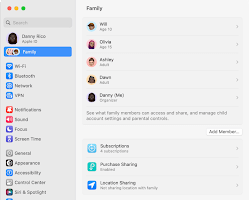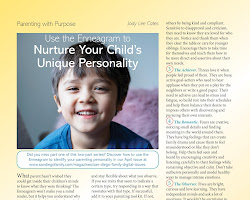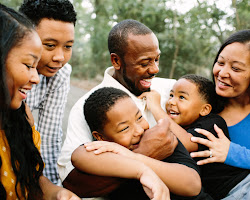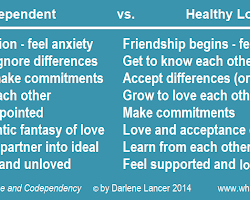Family dynamics play a crucial role in shaping our emotional well-being and interpersonal relationships. One such dynamic that can significantly impact family interactions is co-dependence. In this article, we delve into the intricate aspects of family co-dependence, exploring its dynamics, effects, and strategies for fostering healthier connections.
Table of Contents
Understanding the Co-dependent Dynamic
Co-dependence refers to a relationship pattern where family members become overly reliant on each other for emotional support, validation, and identity. This dynamic often stems from a combination of enabling behaviors, control issues, and unresolved emotions.
Recognizing Signs of Co-dependence
Identifying signs of co-dependence is the first step towards addressing this issue. Signs may include blurred personal boundaries, an inability to make decisions independently, and an emotional reliance on others for self-worth.
 Opens in a new window
Opens in a new window support.apple.com
support.apple.com
- Blurred personal boundaries: Family members may have difficulty setting boundaries between themselves and each other. This can lead to feeling like they are responsible for each other’s emotions and needs.
- Inability to make decisions independently: Co-dependent individuals may have difficulty making decisions on their own. They may constantly seek approval from others or feel like they need someone else to make decisions for them.
- Emotional reliance on others: Co-dependent individuals may rely on others for emotional support and validation. They may feel like they cannot cope with life’s challenges without the help of others.
Exploring Root Causes and Triggers
Co-dependence can often be traced back to family history, trauma, or unhealthy communication patterns. Exploring these root causes helps individuals gain insights into why co-dependent behaviors have developed.
 Opens in a new window
Opens in a new window en.wikipedia.org
en.wikipedia.org
- Family history: Co-dependence can be learned from family members. If a child grows up in a family where co-dependence is the norm, they may be more likely to develop co-dependent behaviors themselves.
- Trauma: Co-dependence can also be a way of coping with trauma. If a person has experienced a traumatic event, they may turn to co-dependent behaviors as a way of feeling safe and secure.
- Unhealthy communication patterns: Unhealthy communication patterns can also contribute to co-dependence. If family members are not able to communicate effectively, they may resort to co-dependent behaviors in order to get their needs met.
The Impact on Individual Identities
Family co-dependence can erode individual identities as family members prioritize the needs of the collective over their personal aspirations and growth. This impact can lead to feelings of resentment, frustration, and unfulfillment.
Interdependence vs. Co-dependence
Understanding the difference between healthy interdependence and co-dependence is crucial. Healthy interdependence involves mutual support and respect, whereas co-dependence leans toward an unhealthy reliance on others.
 Opens in a new window
Opens in a new window www.theatlantic.com
www.theatlantic.com
- Interdependence: Interdependent individuals are able to maintain their own sense of identity while also being supportive of others. They are able to ask for help when they need it, but they also know how to take care of themselves.
- Co-dependence: Co-dependent individuals are unable to maintain their own sense of identity without the support of others. They may feel lost and alone when they are not in a relationship.
Assessing Emotional Boundaries
Healthy family dynamics require clear emotional boundaries. Assessing and communicating these boundaries helps family members understand where their responsibilities lie and where they can offer support.
 Opens in a new window
Opens in a new window www.reddit.com
www.reddit.com
- Emotional boundaries: Emotional boundaries are the limits we set around our emotions. They help us determine what we are willing to share with others and what we need to keep private.
- Communicating boundaries: It is important to communicate our boundaries to others. This can be done directly or indirectly. For example, we can say “I’m not comfortable talking about that” or we can simply change the subject.
Communication Patterns in Co-dependent Families
Co-dependent families often exhibit specific communication patterns, such as avoiding conflict, suppressing emotions, or trying to control each other’s behavior. Recognizing these patterns is essential for breaking the cycle.
- Avoiding conflict: Co-dependent families may avoid conflict at all costs. This can lead to bottling up emotions, which can eventually lead to resentment and anger.
- Suppressing emotions: Co-dependent families may also suppress their emotions. This can lead to feeling numb and disconnected from themselves.
- Trying to control each other’s behavior: Co-dependent families may try to control each other’s behavior. This can be done through manipulation
The Role of Enabling and Control
Enabling behaviors and control mechanisms often fuel co-dependence. Family members may enable destructive behavior or control others to maintain a sense of order.
Breaking Free from Co-dependent Patterns
Breaking free from co-dependent patterns requires a collective effort. Family members must commit to change, challenge negative behaviors, and prioritize personal growth.
Seeking Professional Support
In cases of severe co-dependence, seeking professional guidance is crucial. Therapists can provide tools and strategies for unraveling deeply ingrained co-dependent behaviors.
Building Healthy Family Dynamics
Transitioning from co-dependence to healthier dynamics involves fostering open communication, respecting individual autonomy, and encouraging personal growth.
Nurturing Self-Worth and Autonomy
Individual self-worth and autonomy are fundamental for breaking co-dependent patterns. Encouraging family members to pursue personal passions and interests builds confidence.
Balancing Care and Independence
Balancing care for each other with individual independence is the cornerstone of healthier family relationships. It requires a shift in perspective and a commitment to growth.
 Opens in a new window
Opens in a new window issuu.com
issuu.com
Promoting Openness and Vulnerability
Creating an environment where family members can openly express their thoughts and feelings fosters authentic connections. Vulnerability breeds understanding and empathy.
 Opens in a new window
Opens in a new window www.betterup.com
www.betterup.com
Laying the Foundation for Change
Initiating change requires acknowledging past behaviors, taking responsibility, and setting clear intentions for healthier interactions.
 Opens in a new window
Opens in a new window medium.com
medium.com
Embracing Personal Growth and Healing
Individual healing and growth are integral to transforming co-dependence. Each family member’s journey contributes to the overall well-being of the family unit.
Transforming Co-dependence into Connection
By addressing co-dependence head-on, families can transform it into a deeper sense of connection based on mutual respect, understanding, and support.
 Opens in a new window
Opens in a new window www.psychalive.org
www.psychalive.org
Empowering Family Relationships
Empowering family relationships means valuing each member’s unique qualities, fostering personal growth, and maintaining healthy boundaries.
: “Breaking the chains of co-dependence paves the way for a journey to family flourishing, where authenticity, connection, and individual empowerment thrive.”
Sarah Johnson
Conclusion: A Journey to Family Flourishing
Assessing family co-dependence marks the beginning of a transformative journey. By embracing change, seeking self-awareness, and cultivating healthy communication, families can embark on a path toward greater understanding, love, and shared growth. Breaking the chains of co-dependence paves the way for a journey to family flourishing, where authenticity, connection, and individual empowerment thrive.
Read more articles


